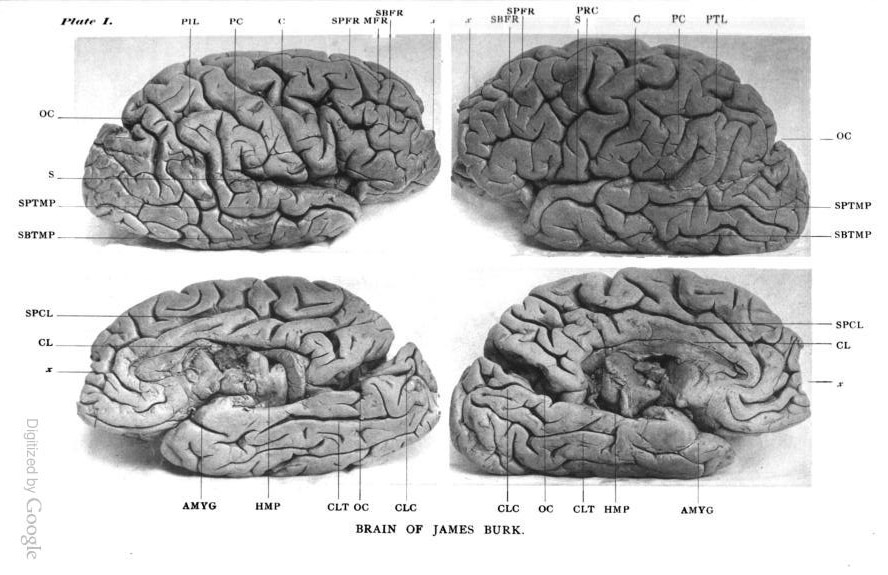
Journal : Journal of nervous and mental disease ; n.s., vol. xi.
New York : G. P. Putnam's sons, 1886.
Description : 517-553 p. [2 l. pl.] ; ill.: 2 phot. figs., 1 tbl. ; 24 cm.
Photograph : 2 leaves with 8 phototype figures of brain specimens.
Photographer : Andrew Jackson Parker (attributed by bibliographer).
Subject : Brain — Abnormalities.
Notes :
In Plate I, we have two views of each of the hemispheres of the brain of Burk–from the dorso-lateral and meso-ventral aspects. The lettering corresponds with the nomenclature of Wilder. A careful comparison of the following description, with the figures and symbols, will serve to bring out the peculiarities of the brain. Small blocks of brain tissue were removed for microscopical examination from the tips of each frontal lobe at x. The photographs were made after the brain had been hardened in zinc chloride and alcohol. Fissures only have been indicated, in order to save too much interference with the appearance of the phototypes. The letters are those given as abbreviations by Wilder.—Page 532.

This is a paper in three parts which begins with an address by Mills to the Neurological Association upon his inauguration as president of that organization. The second section is Mills's paper describing the morphology of the brain of James Burk, who died in a fire that destroyed the insanity ward of Philadelphia Hospital where he was a resident. The third section, on the morphology of a Chinese brain, was co-written by Mills and Parker. Parts I and II are illustrated by photographs representing four views each of the two subject brains. One view from each plate was republished in a paper by Mills titled, Cerebral localization in its practical relations (1889, vide intra: »»).
Dr. Andrew Jackson Parker was the favorite student of Joseph Leidy (1823-1891). With Leidy, he was a member of the American Anthropometric Society, established in 1889, and comprised of distinguished Philadelphia scientists who bequeathed their brains to medical science. Parker's brain, together with that of his mentor Leidy and six other specimens, was studied and described by Edward Anthony Spitzka (1876–1922) in a paper titled, A study of the brains of six eminent scientists and scholars belonging to the American Anthropometric Society..etc. (Phila.: Trans. Amer. Phil. Soc., 1908). After his death, his friends gathered the funds to publish his unrevised monograph, The Morphology of the Cerebral Convolutions with Special Reference to the Order of Primates (Phil. Acad. of Nat. Sci., 1896), a work illustrated by Parker's original drawings and photographs and that was awarded the Harvard Boylston prize in 1890. He died of pneumonia at the age of 36.
